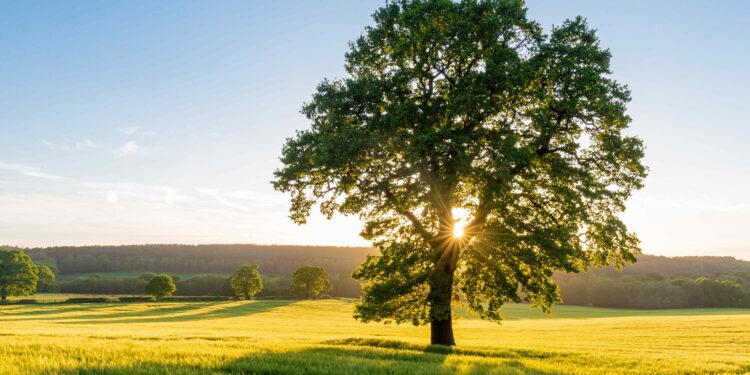Revolutionizing Tree Identification: The Role of Sound Analysis
In a pioneering investigation that fuses ecological science with cutting-edge technology, researchers from the University of Virginia (UVA) have introduced a novel technique for identifying tree species through sound analysis. The classic philosophical inquiry, “If a tree falls in the forest, does it make a sound?” has evolved as scientists delve into the acoustic signatures of trees to ascertain their species, including whether a fallen specimen is a fir or spruce. This research not only deepens our comprehension of forest ecosystems but also presents practical applications for conservation and land management strategies. With global deforestation posing significant threats, findings from UVA could be crucial in monitoring and safeguarding our natural resources.
Exploring Tree Species via Acoustic Signatures
The UVA research team has uncovered fascinating opportunities for identifying tree species through auditory analysis. By recording the unique sounds produced when trees fall, scientists are investigating how these distinct audio patterns correspond to specific types of trees. Utilizing advanced recording technologies, researchers can collect sound data that reflects various physical traits of different tree species, leading to enhanced insights into forest biodiversity and ecosystem dynamics.
The focus of this analysis revolves around several critical characteristics:
- Sound Frequency: Each type of tree generates unique frequencies upon impact with the ground.
- Sound Duration: The length of the sound wave offers clues regarding the size and density of the fallen tree.
- Resonance Characteristics: Variations in resonance can reveal information about the health and structural integrity prior to its fall.
This groundbreaking methodology not only improves our capacity to identify fallen trees but also aids conservation efforts by enabling monitoring of forest health through acoustic means—potentially informing reforestation initiatives and sustainable management practices.
Advanced Techniques Utilized by UVA Researchers
The researchers at UVA have employed state-of-the-art technologies to investigate the intricate relationship between different tree species and their surrounding biotic environments. By leveraging machine learning algorithms, they have created models capable of recognizing various tree types based on auditory data collected during their falls. This innovative strategy utilizes an extensive range of sound properties that allow differentiation among species such as spruces, birches, and willows by analyzing their distinctive acoustic signatures upon hitting the ground. This study highlights how sound can serve as an essential ecological indicator beyond traditional visual identification methods.
This progress is further enhanced by integrating drones equipped with sophisticated sensors, which systematically capture ambient sounds within dense forests. These drones gather comprehensive audio data that contribute to extensive libraries improving accuracy in identifying different species acoustically. Moreover, this project fosters interdisciplinary collaboration among ecologists, data analysts, and acoustics experts who combine their knowledge creatively. Ongoing research aims not just at enriching our understanding but also at developing effective conservation strategies.
Impact on Forest Conservation Strategies
The innovative work conducted at UVA emphasizes both methodological advancements in forestry ecology and significant implications for conservation practices. Gaining insight into how diverse tree types like spruces contribute uniquely to forest ecosystems enables more strategic management approaches tailored towards preserving endangered habitats or supporting rare florae effectively through targeted actions like restoration projects aimed at maintaining biodiversity for future generations.
This research also highlights how vital community engagement is within forestry management initiatives; involving local populations enhances stewardship while improving data collection efforts significantly! When communities are informed about findings from such studies regarding ecological impacts stemming from human activities on forests—educational campaigns can be developed raising awareness about various important aspects related specifically towards conserving these vital ecosystems! Potential strategies may include:
- Workshops focused on recognizing local florae, promoting appreciation for biodiversity within communities.
- Civic science programs, allowing residents active participation in tracking overall health metrics across nearby woodlands!
- Cohesion with educational institutions to integrate forestry topics into school curricula effectively!
< p > Given these revelations , it becomes evident that merging advanced scientific exploration alongside grassroots action proves essential when striving toward resilient ecosystems . As pressures mount against forests due climate change , pollution , urbanization etc., innovative methodologies pioneered by UVA’s team could play pivotal roles shaping sustainable practices moving forward .
< h 2 id = "conclusion" > In Summary
< p > The remarkable investigations undertaken by scientists at UVA illuminate intersections between nature & technology while offering fresh perspectives concerning environmental understanding . Through analyzing vibrations emitted during falling timber events — particularly those associated with conifers —these scholars enhance capabilities surrounding remote identification processes whilst fostering greater awareness regarding intricate dynamics governing woodland habitats’ significance within broader ecological frameworks ! As we confront ongoing environmental challenges ahead , studies like this underscore importance placed upon scientific inquiry unraveling complexities inherent throughout nature itself . Ultimately , exceptional contributions made here stand testament potential discoveries awaiting us all ensuring even amidst tranquil moments found deep inside woods valuable insights continue emerging !






























